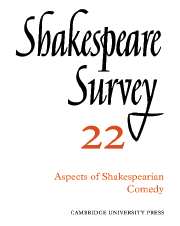Book contents
- Frontmatter
- Old and New Comedy
- An Approach to Shakespearian Comedy
- Shakespeare, Molière, and the Comedy of Ambiguity
- Comic Structure and Tonal Manipulation in Shakespeare and Some Modern Plays
- Laughing with the Audience: ‘The Two Gentlemen of Verona’ and the Popular Tradition
- Shakespearian and Jonsonian Comedy
- Two Magian Comedies: ‘The Tempest’ and ‘The Alchemist’
- ‘Thou that beget’st him that did thee beget’: Transformation in ‘Pericles’ and ‘The Winter’s Tale’
- The Words of Mercury
- Why Does it End Well? Helena, Bertram, and The Sonnets
- Some Dramatic Techniques in ‘The Winter’s Tale’
- Clemency, Will, and Just Cause in ‘Julius Caesar’
- Thomas Bull and other ‘English Instrumentalists’ in Denmark in the 1580s
- Shakespeare in the Early Sydney Theatre
- The Reason Why: The Royal Shakespeare Season 1968
- The Year's Contributions to Shakespearian Study 1 Critical Studies
- 2 Shakespeare’s Life, Times and Stage
- 3 Textual Studies
- Index
- Plate Section
2 - Shakespeare’s Life, Times and Stage
Published online by Cambridge University Press: 28 March 2007
- Frontmatter
- Old and New Comedy
- An Approach to Shakespearian Comedy
- Shakespeare, Molière, and the Comedy of Ambiguity
- Comic Structure and Tonal Manipulation in Shakespeare and Some Modern Plays
- Laughing with the Audience: ‘The Two Gentlemen of Verona’ and the Popular Tradition
- Shakespearian and Jonsonian Comedy
- Two Magian Comedies: ‘The Tempest’ and ‘The Alchemist’
- ‘Thou that beget’st him that did thee beget’: Transformation in ‘Pericles’ and ‘The Winter’s Tale’
- The Words of Mercury
- Why Does it End Well? Helena, Bertram, and The Sonnets
- Some Dramatic Techniques in ‘The Winter’s Tale’
- Clemency, Will, and Just Cause in ‘Julius Caesar’
- Thomas Bull and other ‘English Instrumentalists’ in Denmark in the 1580s
- Shakespeare in the Early Sydney Theatre
- The Reason Why: The Royal Shakespeare Season 1968
- The Year's Contributions to Shakespearian Study 1 Critical Studies
- 2 Shakespeare’s Life, Times and Stage
- 3 Textual Studies
- Index
- Plate Section
Summary
The exuberant energy devoted in recent years to Shakespeare life studies seems at last to have ebbed away, and this year’s contributions to the subject have been both meagre and restrained. With the exception of M. K. Naik, whose delightful, if not highly original, picture of a ‘humanitarian’ Shakespeare is constructed by that process of judicious quotation from the text the dubious fruits of which we have long learned to suspect, scholars have eschewed the alluring paths of speculation and confined themselves to a rigorous re-appraisal of a number of items of evidence available to us. Thus the clothes in which the dramatist is depicted in the various contemporary representations of him, the identity of the subjects of the ‘Barnard’ portraits, the source of John Shakespeare’s spiritual testament, and fresh evidence that the ‘upstart crow’ reference may carry the implication of plagiarism have all been carefully examined, while possible extensions to the Shakespearian canon in the shape of The Double Falsehood or an early version of Titus Andronicus disguised as Titus and Vespasian have both been discounted. Meanwhile Hallett Smith in Shakespearean Research Opportunities urges the need for yet greater precision in the dating of the last plays and more certainty about the authorship of three of them.
- Type
- Chapter
- Information
- Shakespeare Survey , pp. 167 - 176Publisher: Cambridge University PressPrint publication year: 1970

